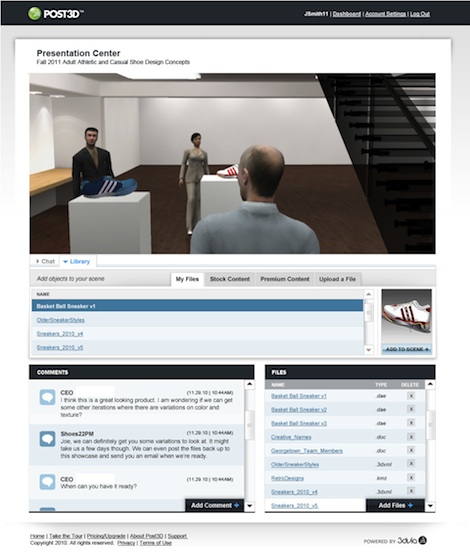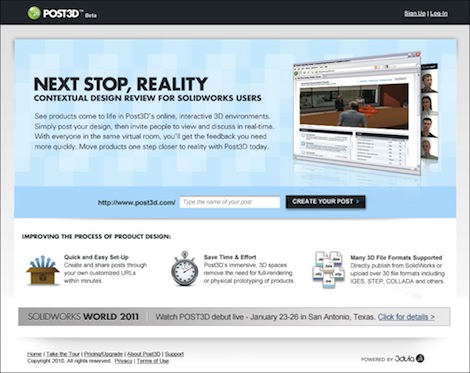Here we are again. A new decade, a new January and another SolidWorks World. If you’re not aware, it’s the annual jamboree for all things SolidWorks and it’s happening this week in San Antonio, Texas. Home of the Alamo and a rather peculiar faux-river.
This morning, the Dassault Systèmes (DS) team unveiled a brand new service offering from the 3DVIA group within the company. 3DVIA is the home for some of DS’s more esoteric and ‘less-pigeon-hole-able’ products. Those in the design or engineering space will probably be most familiar with the technical illustration and documentation system, Composer, but there’s also a whole host of game development tools such as Virtools. Alongside the ‘products’ per se, the group has also been leading many of DS’s online efforts. An excellent example is the 3DVIA Shape initiative which provides a set of modelling tools for creating 3D content which can then be shared using the community-style web-site.
So what’s the deal with POST3D?

Announced this morning, POST3D combines DS’s experience with gaming technology, cloud-based services and, of course, 3D design and builds a 3D collaboration service. Upload a model (formats include IGES, STEP, DAE, 3DS, SolidWorks and, of course, Catia), any related documents and you invite the team working on a project to discuss, interact with the model and make decisions – but here’s the thing, it’s not like other 3D model hosting services.
Firstly, this one has high quality photorealism, which is a benefit of having as a cloud-based service. Secondly, you use an avatar to navigate the environment as you would in a computer game. Walk up to the object you’re working on and away you go, spin, zoom, walk in and around. There’s also talk of being able to use some of 3DVIA’s other tools to add interactivity. Thirdly, the service tracks the commentary from those involved in the project. And the last point is that it’s looking to be pretty cost effective.

It’s going into a Technical Preview phase (expected to last most of the year) and will be free while it lasts. Once that’s over, the premium service will cost around the $49 a month mark (just shy of $600 a year). One thing worth noting is that it’s only the host or owner of the project that is charged. Other participants just log-in and work with it.
In terms of requirements, there will be support for all the major browsers such as IE, Firefox and Chrome, on both 32 and 64-bit machines. There’s also a Mac version (including Safari support) coming later in the year. All you’ll need is a lightweight plug-in installed in your browser of choice.
A few thoughts
There’s a lot of negativity around the use of the word cloud when it comes to professional applications. The move away from the combination of workstation+windows+local client software as a core platform is probably inevitable but one which will most likely require a generational shift before it happens. At the moment, negative change habit, skepticism and rightful concerns over connection speed, reliability, security and many other things mean it’s difficult to see the potential benefits or to even be excited about the prospects. By making services like this available, many vendors are starting to seed the idea that the cloud isn’t such a bad thing and if used in sensible ways, can give users benefits over ‘how things are done at the moment.’ When Windows NT was launched, many in the engineering space scoffed at it from behind their SGI 27″ CRT monitors. Look at where we’re at 10 years later.
When you’re in the vortex of change, particularly when it comes to technology that’s so central to how you make your living, it’s very hard to see the upside of change. But things will change and they will do so quickly. 10 years from now, the IT landscape will be very different indeed.
What we’re also seeing is a time of experimentation, not only from a technology standpoint, but also from a business perspective. None of the vendors have fixed their cloud-offering pricing structures. Do users pay for access, do they pay for storage, for collaboration, computation? If so, how much is tolerable? What bundling options are available? Can you have a staged offering that gives a company 100 CPU hours of computation, 2Tbs of data storage and 10 concurrent user licenses – or do users want to pay per item?
What we’re seeing from many vendors is experimentation with what’s possible. Autodesk have a large number of ‘cloud-based’ projects on it’s Labs web-site and DS is doing much the same with its 3DVIA projects – of which POST3D is the newest. But it certainly won’t be the last. As a service, this looks like it has huge potential for many different users. The whole walking with an avatar thing looks quite twee on the face of it, but it makes sense when you see it in action and think about the potential. Many users develop small products, so the ability to walk around is odd – but still useful. Then when you consider how many work on much larger items, have a requirement to show a product in situ and in context (think building products, think POS items) it makes huge sense. In fact, this would work rather nicely for the AEC market too.
I’m curious about what people think. How would a service like this benefit you, based on first impressions? Does the idea of being able to allow the stakeholders in a project to log-in, interact with a visually rich digital representation of your product excite you? Can you see $49 a month making it’s way into your budgets? Or do you dislike the idea completely? I’d love to know.






